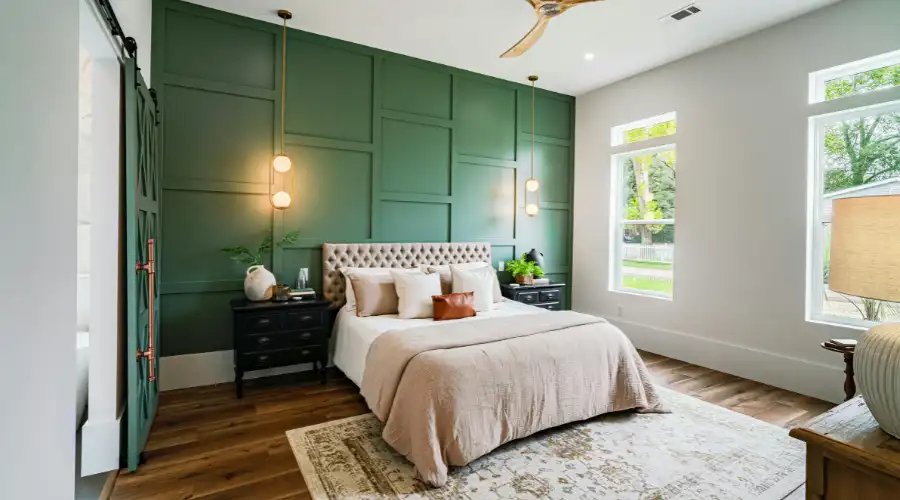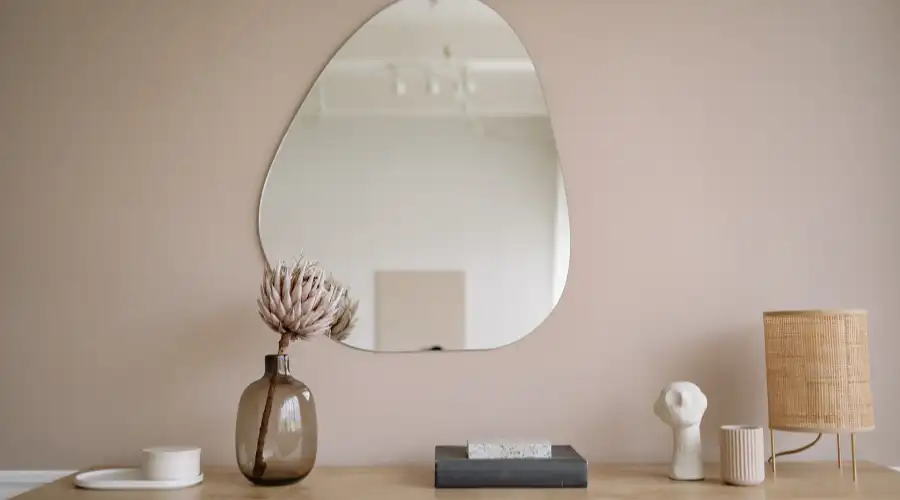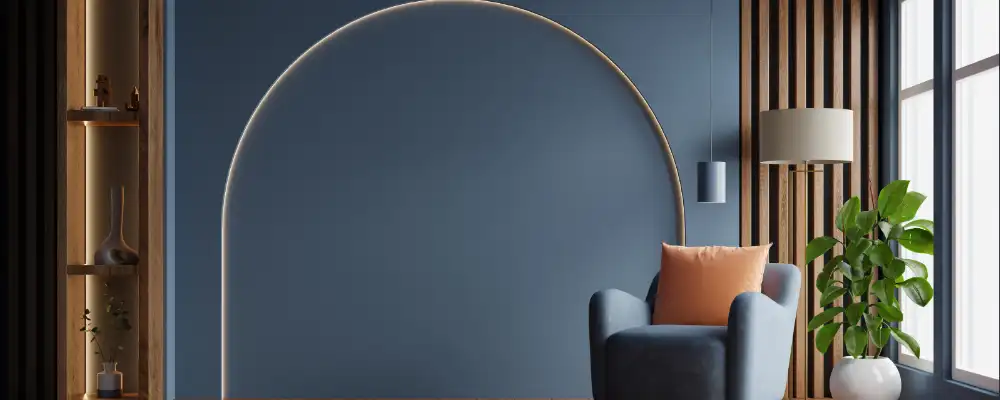Did you ever consider that the interior of a house could have an interesting attraction for guests and create an ambience? You are not the only one. Regardless of whether you’ve been looking for it or it just manifests and makes you want to share the joy with others, anything may happen with just one simple design decision. Shall we know the secret to style and personality at the drop of a hat?
What is an Accent Wall?
An accent wall is defined as a wall, or portion of a wall, in a space that is a different color, texture or pattern than the walls it touches (again, one color will make the accent wall). Most people consider an accent wall mainly as a visual aspect; it also will create a 3-dimensional experience- particularly if the other walls in a room are neutral or the same color. Accent walls will add color and personality as well as contrast and multiple style options- and again particularly if the rest of the room is designed uniformly; it will not compete with the rest of the designs in the room.
The Benefits of Accent Walls in Interior Design

Visually Appealing
A room can benefit from the boost in energy and vitality that an accent wall might provide. Regardless of its hue, its enormous canvases break up the monotony of simpler walls.
Determine the Size of the Rooms
Using a variety of colours and patterns, accent walls may make a room look bigger or smaller, changing its overall appearance. The impression of a deeper room is created by the dark wall at the far end, while the impression of greater space is created by the horizontal stripes.
Cost-effective Change
You can easily change the look and feel of your home’s interior without undergoing a complete renovation by adding an accent wall.
Showcase Architectural Features
Paying attention to fireplaces, built-in bookshelves as part of home library design, or large windows while using accent walls. During the design phase, these characteristics are given more attention and importance.
Present your custom style
Choosing an accent wall is a way to showcase your individuality and creativity. You can use any medium to express your creativity, from simple colours to elaborate murals.
Application of Accent Walls
- The feature wall focusing on the seating area provides a means of emphasis to your fireplace, TV wall, or just the contemporary layout of your living room.
- The headboard wall of your bed creates a kind and lovely backdrop that adds warmth and depth.
- The dining room wall is interesting because the focus is on the room’s fundamental features of wallpaper or paint.
- Home Office – Consider the wall behind your desk to give online meetings a more upscale appearance.
- Establishes the tone for all of the interior design in the home and gives a lasting first impression when you arrive at the room.
- Themes for children’s rooms can utilize bright colors or murals that match the theme in order to create a bright and happy environment.
- When a corridor or hall uses texture, color, or art to break the monotony of a long wall it makes said corridor or hall interesting.
- Recommendations for improving presentations by introducing contrast and depth to the background of bookshelves or bookcases.
- Tiles, wood, or stone are commonly used to highlight the architectural beauty of the bathroom space behind a bathtub or vanity.
- Retail or business branding: accent walls of stores are often fitted with branded logos, colors, or tag lines designed to attract attention and draw clients into spaces.
How to Choose an Accent Wall?
Do’s
- Choose a wall that has a focal point. This might be a fireplace or some other piece of furniture that acts like a magnet for your eyes.
- Consider using moderate natural light. The texture or accent hue of walls that face a window or are exposed to the sun will be highlighted.
- To highlight the remaining furniture’s colours and features.
- Before you decide, take a few brush or roller strokes of the paint or paper in your intended spot and keep the samples. Watch the change of colour by the time of day is important to consider. Consider how the accent wall will look in (a) natural light, (b) artificial light and (c) natural and artificial light.
- There are also options, such as peel-and-stick wallpaper, that can be a temporary solution. But again, think about if you merely want to add some subtle little accent colours to a neutral room – this can add warmth without seeming too overpowering. And finally, think about how the colour or texture of the accent wall fits in with your overall decorated room.
- Experiment with patterns or finishes beyond solid colors for visual interest.
- Pick a wall that will naturally command the eye when entering the space. Check the wall for structural integrity and make sure an accent wall will be free of imperfections. You can check wall design painting for the hall ideas here.
- The accent wall should complement the room, but the bold colour should depart from the rest of the room in a way that provides balance, not overwhelm the space.
Dont’s
- Nothing is wrong with going all out with colour, as long as you avoid walls that clash overall colour of the room.
- Don’t select a wall that is already visually busy, or that may have too much architecture trim, detailing, etc.
- Don’t do dark colors in small room – dark colors shrink, and make the room smaller.
- Avoid using a wall that has too much natural light! Natural light greatly has an effect to wash out an accent color.
- Don’t select any wall that competes with a focal point in the room. A fireplace, major piece of artwork, etc.
- Don’t use a pattern that is busy or complex because it can look visually awkward.
- Don’t forget about light. Accent walls require special lighting to give them character.
- Do not select an accent wall color that is too similar to the main wall color, or the accent wall will not stand out. Do not have an accent wall in very busy rooms, as the accent wall can become visual clutter.
- If you want a well-kept promenade that runs through a wall, don’t use walls with too many windows or doors. The design’s course and effects will be diminished.
- Keep it simple. Because every room should only have one accent wall, the room can sometimes feel cluttered and cramped with the new accent.
- Buy whatever fits your lasting aesthetic choices over what will be in vogue. Don’t be lured by fads.
Choosing Materials and Finishes for Accent Walls
High-quality Paint
Paint is, by far, the simplest and least expensive way to create an accent wall. Using bold, contrasting colors or using more complicated two-tone patterns, like stripes or ombre.
Wallpaper
Peel-and-stick wallpapers are also rent-friendly, and contemporary wallpapers come in a variety of designs and textures, such as floral and metallic.
Accent Wall Panels
Modern, eye-catching designs are made using wood or PVC panels. The sense of touch is evoked by using ship lap, wainscoting wall, or slatted wood patterns.
Textures and Materials
Decide between concrete surfaces, stone cladding, and bare brick. Your design will have an overall rough and industrial feel thanks to these materials.
Patterns and Murals
You can turn a boring wall into a painting by putting on a wall mural. A mural can offer beautiful images of nature, geometric images, or images depicting philosophy.
Comprehensive Manual for Creating a Board and Batten Accent Wall
Board and batten is a classic wall treatment that combines wide boards (planks) with narrow strips (battens) to create a structured, dimensional look. This style has horizontal boards at the top and bottom with equally spaced vertical battens in between. This accent wall design is a classic architectural detail and adds visual interest and texture to the room.
Preparation
Measure the wall to determine the best location for the accent design. Take out the furniture, cover the floor with a drop cloth, and thoroughly clean the wall surface after removing the outlet covers and any necessary molding. Locate the wall studs using a stud finder. Make sure you have your boards, a level, a saw, nails or glue, caulk, primer, paint, and, of course, your boards right now. Put the boards horizontally.
Lay Boards Horizontally
Start by mounting the horizontal top and bottom panels that frame the focal point of the accent wall. Use brads from a nail gun or construction glue to secure them to the wall when they are perfectly level. Use the level. Be sure to leave room for the future installation of baseboards or crown molding as well.
Position Planks Vertically
Measure and mark the positions for consistently spaced vertical battens (boards) along the wall. Fit vertical panels between the top and bottom horizontal pieces; they should be chopped to fit precisely. Before securing, each one should be examined with a level to make sure it is vertical. Depending on the intended appearance, common spacing varies from 12 to 24 inches.
Caulk and Prime
Once the boards are secured, prime and caulk all nail holes, seams, and gaps. Apply the caulk using a tool or your finger, and allow it to dry completely. To provide a smooth, steady painting surface, prime the entire wall including the boards.
Implement Paint Works
Begin by painting the accent wall first. For large surfaces, roller and use a brush in corners and along edges. Use two coats of paint for a gorgeous and durable finished result, allowing for adequate dry time between coats. Every accent wall merits attention; thus, the colour choice must be in a complementary or contrasting hue.
5 Best Ideas for Accent Walls
Color and Tones
The deep blues, forest greens, and dark maroons will quickly grab your attention on the accent wall. Dark colors evoke feelings for people either positively or negatively and may be also very visually stimulating. Softer colors that evoke calm and peaceful thoughts like blush pinks, beige, and baby blue create more of a calmer softer look for the room. The softer tones will tie-in nicely with many other colors especially neutral tones and pastels. You can create a very unique style with either choice, regardless of the size of your space.
Geometric Design
You can use geometric designs created out of triangles, hexagons, or chevrons that can be painted on with stencils and painters’ tape to create excitement and visual interest in the rest of the room. Geometric designs usually also produce a modern image and create a structure in the space. You could easily mix contrasting colours for various shapes you wanted to paint, or you could stick with a monochromatic colour to keep things minimalistic with a simple, sleek look. There are endless possibilities with geometric designs, so you would definitely be able to design something sustainable for your interior style!
Textured Surfaces
If you want something more tactile in nature or a more dynamic accent wall, consider looking at some textured options such as rustic brick, wood batten or 3D panels. Textured materials are visually and physically stimulating and create an inviting layered experience. Textured materials are great options with industrial-themed or contemporary designs, where, once again, raw, unfinished materials can create a particular ambience in a room. Wood slats add warmth and organic coziness, while rustic brick or concrete can add a bit of edgy slickness to the environment. This option gives another multi-sense, look and tactile experience.
Use Wallpaper
Wallpaper can be an instant and simple way to add personality and style to any accent wall. You can use it in any design genre – plants, art deco, botanical prints – you can bring together deep textures and bold designs using wallpaper, as each is open-ended for interpretation. Creating your own wallpaper leaves you with limitless options for infinite opportunities to express creativity and individuality. With wallpaper, you have unlimited styles, colours, and textures. Wallpaper can manifest just about any vision by design, from motifs of vintage textiles or nature-inspired, to a sophisticated geometric pattern across your accent wall.
Include Mirror

A mirrored accent wall is an excellent choice if you’re looking to enhance light and make the space feel larger. Mirrors reflect light, which can brighten up dark areas and create the illusion of more space, making it perfect for small rooms or apartments. The reflective surface adds a luxurious touch, creating depth and a sense of openness. Whether you use a large single mirror or a collection of smaller mirrors arranged artistically, this accent wall idea helps in adding both style and functionality. It’s a clever way to visually expand a room while also contributing to a brighter, more airy atmosphere.
Lastly,
An accent wall is one of the simplest yet most impactful ways to bring life into a room and create a memorable visual statement. The wall should reveal something about your personality, whether it’s wood paneling, paint, wallpaper, or anything else creative. Furthermore, it should complement the rest of your furniture. By using an accent wall, you can transform a drab room into something genuinely spectacular if you are a bit creative and plan ahead.

